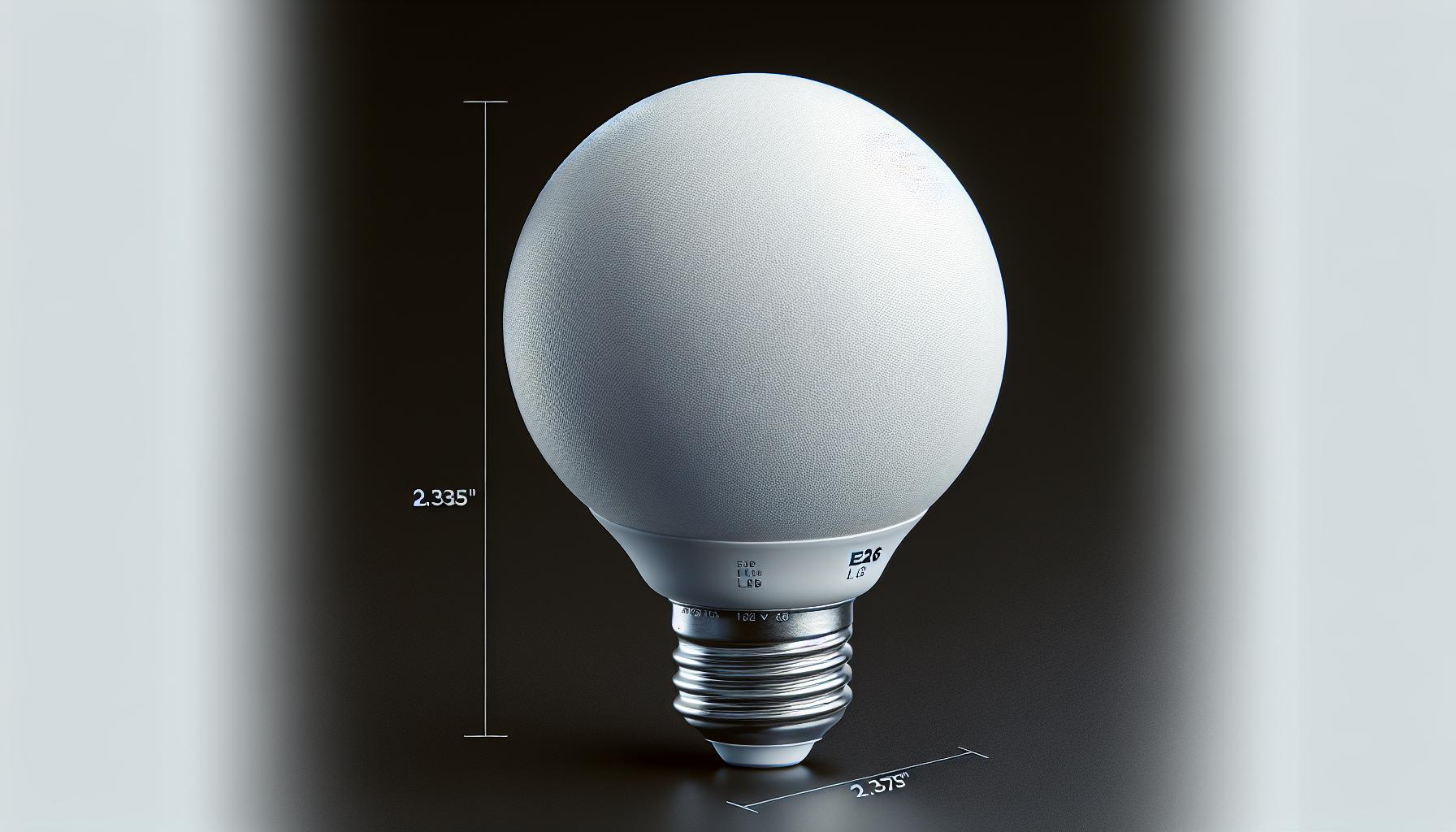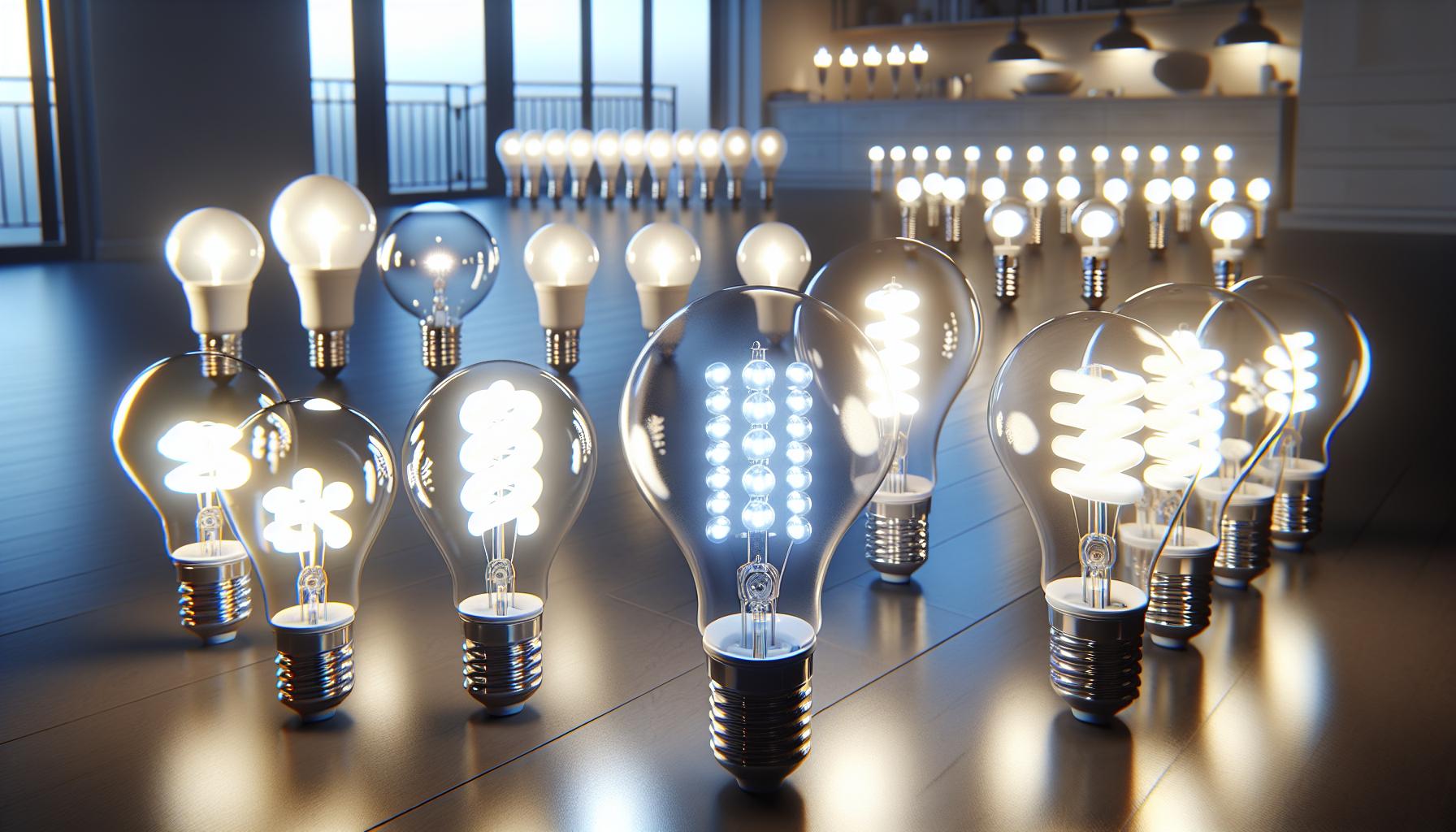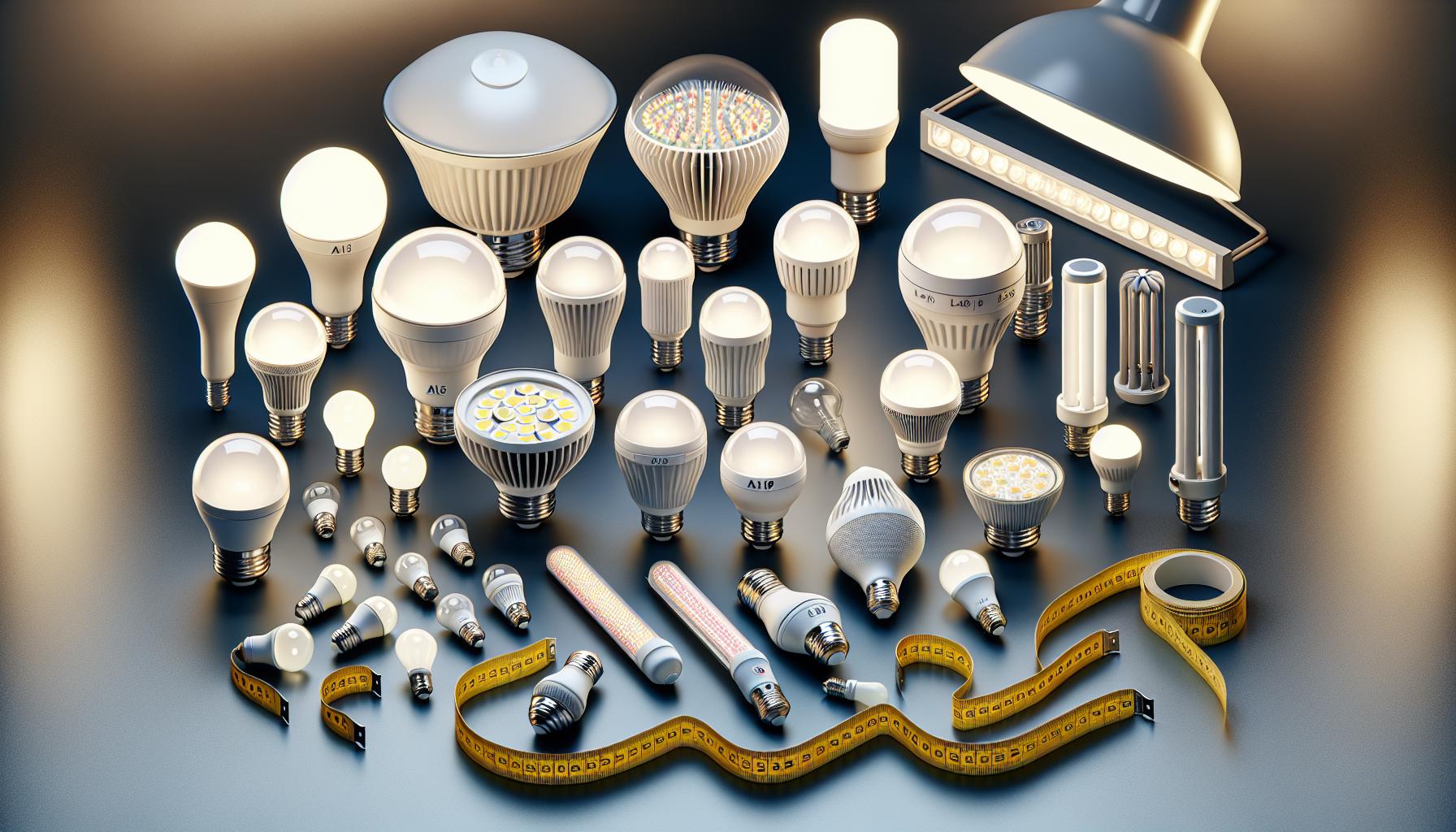Ever found yourself staring at the light bulb aisle, wondering what the heck the difference is between an A15 and an A19 bulb? You’re not alone. These bulbs might look similar, but they’re like cousins—related but with their own quirks.

What is an A15 light bulb?
Chances are, you’ve seen A15 light bulbs around, often in appliances and smaller fixtures. These bulbs are built for specific purposes where a compact size and lower light output are preferred. The ‘A’ in A15 stands for the bulb shape, which is “Arbitrary” – the technical term for the classic light bulb shape that’s been brightening homes for over a century.
Typically, the A15 bulb comes with a smaller wattage compared to other household bulbs. You’ll find these bulbs used in:
- Refrigerators
- Ovens
- Decorative fixtures
Here’s a little more insight into these compact powerhouses:
- Diameter: The defining size indicator for an A15 bulb is its diameter, measured in eighths of an inch. So, an A15 has a diameter of 15 eighths of an inch, or roughly 1.875 inches.
- Base: These bulbs typically come with an E26 base, which is the standard base size for most light fixtures in your home. This means they’re quite versatile, despite their smaller size.
- Wattage and Lumens: As an enthusiast for lighting up lives, you’ll appreciate that A15 bulbs usually range from about 15 to 40 watts, making them ideal for creating a cozy, warm atmosphere. They emit less light, which is measured in lumens, than their A19 counterparts.
It’s fascinating that, given their utilitarian design, the A15 bulbs still manage to emit a charm that’s reminiscent of the early days of electric lighting. When walking down the lighting aisle, the A15 might not stand out at first glance, but their unique attributes ensure they shine in their own niche areas of your home.
Next time you’re embarking on a DIY project or simply replacing a bulb in your appliance, you’ll realize that these small yet robust bulbs represent the subtle intricacies of functional design melded with stellar performance. So keep an eye out for A15 bulbs the next time you need a specific lighting solution for those smaller spaces.
What is an A19 light bulb?
So you’re familiar with the quaint A15 bulb for your specific small-space lighting needs. But now, let’s shed some light on its bigger cousin, the A19 light bulb. It’s your standard, go-to bulb that likely springs to mind when you think of a traditional incandescent bulb. Bigger and more rounded than the A15, the A19 is a classic in home lighting.
The ‘A’ in A19 stands for Arbitrary – the technical name for the pear-shaped design we’ve all grown to love. The ’19’ represents the diameter of the bulb at its widest point, which measures 19 eighths of an inch, or roughly 2.375 inches. You’ve likely screwed an A19 bulb into a reading lamp or ceiling fixture without even realizing it. This bulb isn’t just a spur-of-the-moment choice; it’s a staple in home lighting.
Key Features of A19 Bulbs
When it comes to power, the A19 bulb doesn’t shy away. Typically, you’ll find:
- Voltages ranging from 120 to 130 volts
- Wattages spanning from 40 watts to as high as 100 watts
Below is a table that breaks down standard A19 bulb wattages and the approximate lumens they produce:
| Wattage (W) | Lumens (lm) |
|---|---|
| 40W | 450 lm |
| 60W | 800 lm |
| 75W | 1100 lm |
| 100W | 1600 lm |
The A19 bulb is available with various base sizes to fit standard light sockets, but the most common base size you’ll encounter is E26, which is the medium-sized screw base in the United States. That’s right, you can pick up an A19 bulb and confidently pitch it into most of your home fixtures with ease.
Not only does it excel in versatility, but the modern A19 bulb also comes in an array of options. You have LED versions that promise energy efficiency and long life, dimmable models to set the ambiance just right, and even smart bulbs, which you can control with a tap on your smartphone. Whatever your lighting project, A19 bulbs are likely to be your bread and butter.
Physical Differences between A15 and A19 light bulbs
« How Does Light Bulb Make Our Life Convenient Today: Illuminate Your Space Smarter
Can a Person Light a Light Bulb? The Shocking Truth About Human Conductivity »
When you’re standing in the light bulb aisle, trying to pick out the right bulb, it’s easy to get overwhelmed. Especially since A15 and A19 light bulbs look pretty similar at a glance. But, trust me, they’ve got some key physical distinctions that’ll affect your choice depending on your fixture’s requirements and the ambiance you’re aiming for in your space.
First off, the numbers in their names are not just random; they indicate the bulb’s diameter in eighths of an inch. So here’s the deal: an A15 bulb has a diameter of 15 eighths of an inch, which is roughly under 2 inches. Meanwhile, an A19 bulb, being the big cousin, measures 19 eighths of an inch, or about 2.375 inches across. Although it might not sound like much, this difference can significantly impact how the bulb fits in different lamps or fixtures.
Length is another differentiator. The A15 bulb is typically shorter than the A19. This is crucial for smaller fixtures where a longer bulb like the A19 might protrude awkwardly or simply not fit. For your cozy reading nook or that sleek desk lamp you love, size matters—and sometimes, smaller is better.
And let’s talk about design applications. The A15’s smaller form factor isn’t just for show; it often means they fit better in appliances or specific types of decorative lighting where a compact bulb is essential. On the other hand, A19 bulbs are the go-to for general lighting purposes. They fill space with light efficiently, making them the workhorses of indoor lighting.
Remember, while you’re aiming for that perfect home ambiance or trying to spotlight your latest DIY project, ensuring the bulb fits your fixture both in size and style is key to getting the best results. So keep a tape measure handy and know your fixture’s dimensions—it’s better to be sure than to end up in the dark.
Light Output and Brightness
When you’re browsing for the perfect bulb, you’ll often see the term ‘lumens’ on the packaging. Lumens measure the total amount of visible light emitted by a source, which means they tell you how bright the bulb is. Traditionally, you might have referred to wattage to gauge a bulb’s brightness, but since energy-efficient bulbs have hit the market, lumens are the real indicator of brightness.
For A15 and A19 bulbs, the lumens can vary, although they typically share a similar range due to their common use in household lighting. However, it’s crucial to note that an A19 bulb often has a wider range of lumens available compared to the A15. This is because A19 bulbs are more frequently used for general lighting purposes and therefore are made to accommodate varying levels of brightness.
| Type | Lumens Range |
|---|---|
| A15 | 250 – 900 |
| A19 | 300 – 1600+ |
A higher lumen count means the bulb is brighter. If you’re looking to replace an old incandescent, you might want to aim for an A19 bulb if you need more light output. For areas where soft light is sufficient, such as in appliances or for accent lighting, an A15 bulb could be the ideal choice.
It’s also worth mentioning that the beam angle of the bulb can influence how the light is distributed in a room. A19 bulbs generally have a wider beam angle, spreading light over a larger area and making them suitable for most room sizes. On the other hand, A15 bulbs might have a narrower beam, concentrating light more intensely within a smaller area.
Remember, choosing the right level of brightness isn’t just about achieving the mood or look you want; it’s also about practicality and energy efficiency. Opt for LED options wherever possible; they provide the same brightness for a fraction of the wattage, which leads to both lower electricity bills and a longer lifespan for your bulbs. Keep in mind that color temperature plays a role too, with warmer colors creating a cozy atmosphere and cooler colors being ideal for task lighting where focus is key.
Choosing the right bulb for your needs
When diving into the world of light bulbs, the choice between A15 and A19 models isn’t just about size. Think of lighting as an ingredient that can completely alter the ambiance and functionality of your space. If you’re a DIY enthusiast or love tinkering with home improvements, you know that picking the right bulb is as crucial as selecting the right paint color.
For task lighting, like under cabinets or in a reading nook, A15 bulbs are your go-to options. Their narrow beam angle focuses light precisely where you need it, giving you clear visibility for detailed tasks. Don’t let their compact size fool you; these bulbs pack quite a punch when it comes to shining a light on your latest project.
In contrast, if you’re looking to brighten up a larger area like a living room or kitchen, A19 bulbs will serve you well. With their wider beam angle, these bulbs provide uniform light distribution, making the room feel more open and inviting. And, thanks to the variety of lumens available, you can choose exactly how much brightness you need for that cozy reading corner or vibrant gathering space.
Here’s another tip: while lumens measure brightness, the color temperature of the bulb will influence the mood. Warm white lights, typically around 2700K to 3000K on the Kelvin scale, create a welcoming and relaxed atmosphere, while cooler white lights above 5000K mimic daylight and can increase alertness and productivity.
Remember, energy efficiency is not just good for the planet, it’s great for your wallet. LED bulbs, whether A15 or A19, are the champions of low energy consumption and long life spans. So, when you’re perusing the aisle for the perfect bulb, consider LED options that balance ambiance with efficiency.
Finally, take into account the fixture you have at home. Whether it’s a pendant light, a floor lamp, or a recessed can light, ensure the bulb’s base and shape fit. Nothing’s more frustrating than a DIY project stalled by a bulb that doesn’t fit the bill—or the lamp, in this case. Keep that measuring tape in your toolkit as an essential ally for your lighting endeavors.
Conclusion
So now you’ve got the scoop on the subtle yet significant differences between A15 and A19 light bulbs. Remember to match the bulb to your space’s needs—A15 for focused tasks and A19 to brighten up larger areas. Don’t forget to consider color temperature to set the right mood and always check the fixture compatibility. With LED options, you’ll enjoy both energy savings and a longer bulb life. Happy lighting!
Frequently Asked Questions
What are the main differences between A15 and A19 light bulbs?
A15 light bulbs have a smaller form factor and a narrower beam angle for focused light, while A19 bulbs are larger with a wider beam angle for broader light distribution.
Why are lumens important when choosing a light bulb?
Lumens measure the brightness of a light bulb. A higher lumen count indicates a brighter bulb, which is essential for determining the amount of light needed for a specific area or task.
Can A19 bulbs offer a wider range of lumens compared to A15 bulbs?
Yes, A19 bulbs generally have a wider range of lumens available, making them suitable for various lighting situations from dim to very bright.
Should I choose A15 or A19 bulbs for task lighting?
For task lighting, which requires focused light, A15 bulbs are often recommended due to their narrower beam angle.
Why should I consider the beam angle when selecting a light bulb?
The beam angle affects how light is distributed. A wider angle can illuminate a larger area, while a narrower angle focuses the light on a specific spot, which can be important depending on the intended use.
How does color temperature influence the mood of a space?
Color temperature, measured in Kelvin, impacts the mood and ambience of a space. Warmer temperatures (lower Kelvin) create a cozy, inviting atmosphere, while cooler temperatures (higher Kelvin) result in a more alert and productive environment.
What should I take into account regarding the fixture when choosing a light bulb?
Consider the size of the fixture and the desired aesthetic effect. Certain fixtures may only accommodate certain bulb sizes or shapes, and the bulb’s visibility in the fixture can influence the look and feel of the space.
Why are LED bulbs recommended over other types?
LED bulbs are recommended for their energy efficiency, long lifespan, and the wide range of options available in terms of brightness, color temperature, and dimming capabilities.




